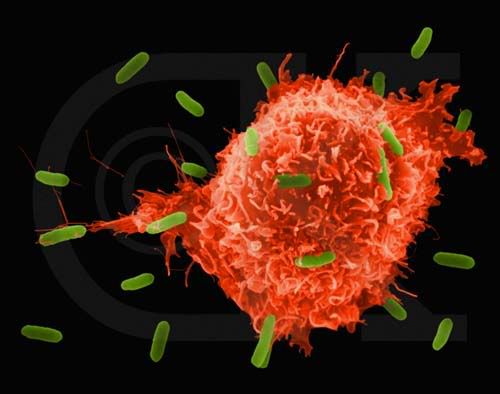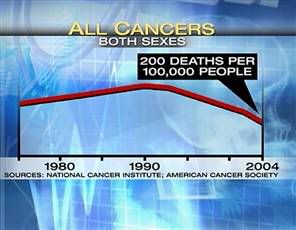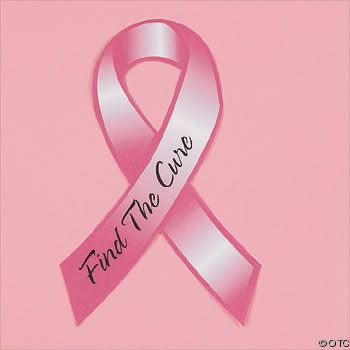
U.S. Cancer Death Rate Continues to Fall
http://www.forbes.com/forbeslife/health/feeds/hscout/2007/10/15/hscout609040.html
MONDAY, Oct. 15 (HealthDay News) -- Death rates from cancer are dropping more quickly across the United States, offering what an expert called a "glimmer of hope" against a leading killer.
According to a new report, cancer death rates fell by 2.1 percent each year from 2002 through 2004 -- almost double the 1.1 percent annual decline recorded between 1993 and 2003.
"That's a very encouraging finding. It's the key indicator of progress in cancer," said Dr. David Espey, a cancer epidemiologist from the U.S. Centers for Disease Control and Prevention in Atlanta who was assigned to the Indian Health Service Division of Epidemiology and Disease Control, in Albuquerque, N.M.
Espey is lead author of the Annual Report to the Nation on the Status of Cancer, 1975-2004, Featuring Cancer in American Indians and Alaska Natives. appearing in the Nov. 15 issue of the journal Cancer.
The acceleration in decline of cancer deaths is "a good news story," added Dr. Corey J. Langer, director of thoracic and head and neck medical oncology at Fox Chase Cancer Center in Philadelphia. "It's the first glimmer of hope in a long time," he said.
The report, which appears annually, is a joint effort from the American Cancer Society, the U.S. Centers for Disease Control and Prevention, the U.S. National Cancer Institute, and the North American Association of Central Cancer Registries.
Data on new cancer diagnoses came from state and regional population-based cancer registries, while data on cancer deaths came from the CDC's National Vital Statistics System.
Most of the top 15 cancers in both men and women experienced declines in death rates. Notably, men saw declines in death rates for lung, prostate and colorectal cancers, while women saw declines in colorectal and breast cancer. In addition, the increase in death rates from lung cancer among women slowed considerably.
Overall, incidence rates for all cancers decreased slightly from 1992 through 2004, after increasing between 1975 and 1992.
There were declines in the incidence of lung cancer in men, colorectal cancer in both men and women and breast cancer in women from 2001 through 2004. The breast cancer declines could be due to declines in the use of hormone replacement therapy, experts said.
Lung cancer incidence in women stabilized from 1998 through 2004, after a long period of increases. In men, the lung cancer rate declined 1.8 percent annually from 1991 through 2004. Rates of colorectal cancer fell by more than 2 percent per year for both men and women, probably because of better screening and removal of precancerous polyps.
"This is the first time we have seen good news in lung cancer," Langer said. "It's probably mostly a reflection of the drop in smoking rates."
This year's report also gives a detailed view of cancer in American Indians and Alaska Natives across the United States. American Indians and Alaska Natives (AI/AN) generally had lower rates of most cancers than non-Hispanic whites between 1999 and 2004, but they had a higher incidence of cancers of the stomach, liver, kidney, gallbladder and cervix.
Incidence rates in these populations varied largely depending on the specific geographic region. From 1999 through 2004, AI/AN men from the Northern Plains region and AI/AN women from Alaska and the Northern and Southern Plains had higher incidence rates than non-Hispanic white men and women living in the same areas.
Lung and colorectal cancer incidence rates were the highest in the Northern Plains and Alaska. AI/AN women, regardless of location, were less likely than non-Hispanic white women to be diagnosed with early breast cancer.
AI/AN populations have less access to cancer prevention and control services, experts note. They also have higher smoking rates as well as higher rates of obesity, both of which can contribute to cancer.
"The issue of cancer in Native Americans has not previously been reported this broadly," Espey said. "The findings point to a need for intervention. These populations have low screening rates. Regionally, there are very specific needs that should drive policy."
And in cancer control, overall, there is still work to do.
"We have a lot of work in colorectal cancer," Espey said. "We've been making progress in lung cancer, but that's a perennial battle to try to control tobacco use initiation and tobacco cessation."
The "low-hanging fruit" in terms of cancer prevention and early detection right now is colorectal cancer, Espey continued. Less progress has been made here than in breast and cervical cancer, he said.
Cancer Statistics
http://www.cancer.gov/statistics/finding
Understanding Prognosis and Cancer Statistics
http://www.cancer.gov/cancertopics/factsheet/support/prognosis-stats

Cancer Death Rates Dropping Fast
Cancer Death Rates Are Dropping Faster Than Ever, According to Annual Report
http://abcnews.go.com/Health/CancerPreventionAndTreatment/wireStory?id=3729688
Good news on the cancer front: Death rates are dropping faster than ever, thanks to new progress against colorectal cancer.
A turning point came in 2002, scientists conclude Monday in the annual "Report to the Nation" on cancer. Between 2002 and 2004, death rates dropped by an average of 2.1 percent a year.
That may not sound like much, but between 1993 and 2001, deaths rates dropped on average 1.1 percent a year.
The big change was a two-pronged gain against colorectal cancer.
While it remains the nation's No. 2 cancer killer, deaths are dropping faster for colorectal cancer than for any other malignancy by almost 5 percent a year among men and 4.5 percent among women.
One reason is that colorectal cancer is striking fewer people, the report found. New diagnoses are down roughly 2.5 percent a year for both men and women, thanks to screening tests that can spot precancerous polyps in time to remove them and thus prevent cancer from forming.
Still, only about half the people who need screening everyone over age 50 gets checked.
"If we're seeing such great impact even at 50 percent screening rates, we think it could be much greater if we could get more of the population tested," said Dr. Elizabeth Ward of the American Cancer Society, who co-wrote the report with government scientists.
The other gain is the result of new treatments, which are credited with doubling survival times for the most advanced patients.
In 1996, there was just one truly effective drug for colon cancer. Today, there are six more, giving patients a variety of chemotherapy cocktails to try to hold their tumors in check, said Dr. Louis Weiner, medical oncology chief at Philadelphia's Fox Chase Cancer Center and a colorectal cancer specialist.
"I can tell you the offices of gastrointestinal oncologists around the country, and indeed around the world, are busier than ever because our patients are doing better," he said.
Among the report's other findings:
Cancer mortality is improving faster among men, with drops in death rates of 2.6 percent a year compared with 1.8 percent a year for women.
Lung cancer explains much of the gender difference. Male death rates are dropping about 2 percent a year while female death rates finally are holding steady after years of increases. Smoking rates fell for men before they did for women, so men reaped the benefits sooner.
Overall, the rate of new cancer diagnoses is inching down about one-half a percent a year.
New breast cancer diagnoses are dropping about 3.5 percent a year, a previously reported decline due either to women shunning postmenopausal hormone therapy or to fewer getting mammograms.
The report includes a special focus on cancer among American Indians and Alaskan natives. Overall, cancer incidence is lower among those populations than among white Americans, except for cancers of the stomach, liver, kidney, gallbladder and cervix.
The annual report is a collaboration of the American Cancer Society, National Cancer Institute, Centers for Disease Control and Prevention, and North American Association of Central Cancer Registries.

Cancer death rates dropping faster than ever
Researchers cite progress against colorectal cancer
http://www.msnbc.msn.com/id/21299632/
WASHINGTON - Good news on the cancer front: Death rates are dropping faster than ever, thanks to new progress against colorectal cancer.
A turning point came in 2002, scientists conclude Monday in the annual “Report to the Nation” on cancer. Between 2002 and 2004, death rates dropped by an average of 2.1 percent a year.
That may not sound like much, but between 1993 and 2001, deaths rates dropped on average 1.1 percent a year.
The big change was a two-pronged gain against colorectal cancer.
While it remains the nation’s No. 2 cancer killer, deaths are dropping faster for colorectal cancer than for any other malignancy — by almost 5 percent a year among men and 4.5 percent among women.
One reason is that colorectal cancer is striking fewer people, the report found. New diagnoses are down roughly 2.5 percent a year for both men and women, thanks to screening tests that can spot precancerous polyps in time to remove them and thus prevent cancer from forming.
Still, only about half the people who need screening — everyone over age 50 — gets checked.
“If we’re seeing such great impact even at 50 percent screening rates, we think it could be much greater if we could get more of the population tested,” said Dr. Elizabeth Ward of the American Cancer Society, who co-wrote the report with government scientists.
The other gain is the result of new treatments, which are credited with doubling survival times for the most advanced patients.
In 1996, there was just one truly effective drug for colon cancer. Today, there are six more, giving patients a variety of chemotherapy cocktails to try to hold their tumors in check, said Dr. Louis Weiner, medical oncology chief at Philadelphia’s Fox Chase Cancer Center and a colorectal cancer specialist.
“I can tell you the offices of gastrointestinal oncologists around the country, and indeed around the world, are busier than ever because our patients are doing better,” he said.
Among the report’s other findings:
Cancer mortality is improving faster among men, with drops in death rates of 2.6 percent a year compared with 1.8 percent a year for women.
Lung cancer explains much of the gender difference. Male death rates are dropping about 2 percent a year while female death rates finally are holding steady after years of increases. Smoking rates fell for men before they did for women, so men reaped the benefits sooner.
Overall, the rate of new cancer diagnoses is inching down about one-half a percent a year.
New breast cancer diagnoses are dropping about 3.5 percent a year, a previously reported decline due either to women shunning postmenopausal hormone therapy or to fewer getting mammograms.
The report includes a special focus on cancer among American Indians and Alaskan natives. Overall, cancer incidence is lower among those populations than among white Americans, except for cancers of the stomach, liver, kidney, gallbladder and cervix.
The annual report is a collaboration of the American Cancer Society, National Cancer Institute, Centers for Disease Control and Prevention, and North American Association of Central Cancer Registries.
Cancer, statistics and ethnic representation in medical trials













![Brotherhood" (2006) [TV-Series]](http://photos1.blogger.com/x/blogger2/1421/379621144723082/211/z/425926/gse_multipart33129.jpg)







No comments:
Post a Comment